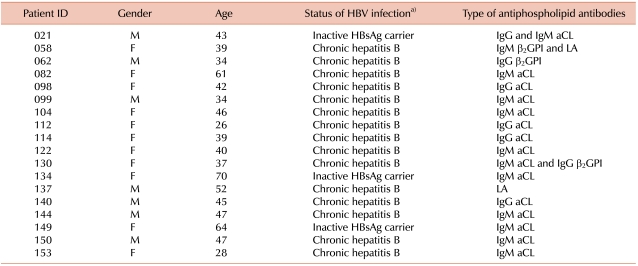1. Levine JS, Branch DW, Rauch J. The antiphospholipid syndrome. N Engl J Med. 2002; 346:752–763. PMID:
11882732.

2. Tarr T, Lakos G, Bhattoa HP, et al. Clinical thrombotic manifestations in SLE patients with and without antiphospholipid antibodies: a 5-year follow-up. Clin Rev Allergy Immunol. 2007; 32:131–137. PMID:
17916982.

3. Giannakopoulos B, Passam F, Rahgozar S, Krilis SA. Current concepts on the pathogenesis of the antiphospholipid syndrome. Blood. 2007; 109:422–430. PMID:
16985176.

4. Vega-Ostertag ME, Pierangeli SS. Mechanisms of aPL-mediated thrombosis: effects of aPL on endothelium and platelets. Curr Rheumatol Rep. 2007; 9:190–197. PMID:
17531171.

5. Cervera R, Asherson RA. Antiphospholipid syndrome associated with infections: clinical and microbiological characteristics. Immunobiology. 2005; 210:735–741. PMID:
16325491.

6. Avcin T, Toplak N. Antiphospholipid antibodies in response to infection. Curr Rheumatol Rep. 2007; 9:212–218. PMID:
17531174.

7. Sorice M, Pittoni V, Griggi T, et al. Specificity of anti-phospholipid antibodies in infectious mononucleosis: a role for anti-cofactor protein antibodies. Clin Exp Immunol. 2000; 120:301–306. PMID:
10792380.

8. Sène D, Piette JC, Cacoub P. Antiphospholipid antibodies, antiphospholipid syndrome and infections. Autoimmun Rev. 2008; 7:272–277. PMID:
18295729.

9. Bloom EJ, Abrams DI, Rodgers G. Lupus anticoagulant in the acquired immunodeficiency syndrome. JAMA. 1986; 256:491–493. PMID:
3088292.

10. Blank M, Shoenfeld Y. Beta-2-glycoprotein-I, infections, antiphospholipid syndrome and therapeutic considerations. Clin Immunol. 2004; 112:190–199. PMID:
15240163.

11. Romero Gómez M, García ES, Lacomba DL, Marchante I, Grande L, Fernandez MC. Antiphospholipid antibodies are related to portal vein thrombosis in patients with liver cirrhosis. J Clin Gastroenterol. 2000; 31:237–240. PMID:
11034005.
12. Kida Y, Maeshima E, Yamada Y. Portal vein thrombosis in a patient with hepatitis C virus-related cirrhosis complicated with antiphospholipid syndrome. Rheumatol Int. 2009; 29:1495–1498. PMID:
19184031.

13. Ramos-Casals M, Cervera R, Lagrutta M, et al. Clinical features related to antiphospholipid syndrome in patients with chronic viral infections (hepatitis C virus/HIV infection): description of 82 cases. Clin Infect Dis. 2004; 38:1009–1016. PMID:
15034835.

14. Guglielmone H, Vitozzi S, Elbarcha O, Fernandez E. Cofactor dependence and isotype distribution of anticardiolipin antibodies in viral infections. Ann Rheum Dis. 2001; 60:500–504. PMID:
11302873.

15. Ordi-Ros J, Villarreal J, Monegal F, Sauleda S, Esteban I, Vilardell M. Anticardiolipin antibodies in patients with chronic hepatitis C virus infection: characterization in relation to antiphospholipid syndrome. Clin Diagn Lab Immunol. 2000; 7:241–244. PMID:
10702499.

16. Harada M, Fujisawa Y, Sakisaka S, et al. High prevalence of anticardiolipin antibodies in hepatitis C virus infection: lack of effects on thrombocytopenia and thrombotic complications. J Gastroenterol. 2000; 35:272–277. PMID:
10777156.

17. Zachou K, Liaskos C, Christodoulou DK, et al. Anti-cardiolipin antibodies in patients with chronic viral hepatitis are independent of beta2-glycoprotein I cofactor or features of antiphospholipid syndrome. Eur J Clin Invest. 2003; 33:161–168. PMID:
12588291.

18. Lee KS, Kim DJ. Management of Chronic Hepatitis B. Korean J Hepatol. 2007; 13:447–488. PMID:
19054901.

19. Brandt JT, Triplett DA, Alving B, Scharrer I. Criteria for the diagnosis of lupus anticoagulants: an update. On behalf of the Subcommittee on Lupus Anticoagulant/Antiphospholipid Antibody of the Scientific and Standardisation Committee of the ISTH. Thromb Haemost. 1995; 74:1185–1190. PMID:
8560433.
20. Harel M, Aron-Maor A, Sherer Y, Blank M, Shoenfeld Y. The infectious etiology of the antiphospholipid syndrome: links between infection and autoimmunity. Immunobiology. 2005; 210:743–747. PMID:
16325492.

21. Amin NM. Antiphospholipid syndromes in infectious diseases. Hematol Oncol Clin North Am. 2008; 22:131–143. PMID:
18207071.

22. Devreese K, Hoylaerts MF. Laboratory diagnosis of the antiphospholipid syndrome: a plethora of obstacles to overcome. Eur J Haematol. 2009; 83:1–16. PMID:
19226362.

23. Elefsiniotis IS, Diamantis ID, Dourakis SP, Kafiri G, Pantazis K, Mavrogiannis C. Anticardiolipin antibodies in chronic hepatitis B and chronic hepatitis D infection, and hepatitis B-related hepatocellular carcinoma. Relationship with portal vein thrombosis. Eur J Gastroenterol Hepatol. 2003; 15:721–726. PMID:
12811301.

24. Uthman IW, Gharavi AE. Viral infections and antiphospholipid antibodies. Semin Arthritis Rheum. 2002; 31:256–263. PMID:
11836658.

25. Dalekos GN, Zachou K, Liaskos C. The antiphospholipid syndrome and infection. Curr Rheumatol Rep. 2001; 3:277–285. PMID:
11470045.

26. Alric L, Oskman F, Sanmarco M, et al. Association of antiphospholipid syndrome and chronic hepatitis C. Br J Rheumatol. 1998; 37:589–590. PMID:
9651099.

27. Galli M, Luciani D, Bertolini G, Barbui T. Lupus anticoagulants are stronger risk factors for thrombosis than anticardiolipin antibodies in the antiphospholipid syndrome: a systematic review of the literature. Blood. 2003; 101:1827–1832. PMID:
12393574.

28. Devreese K, Hoylaerts MF. Challenges in the diagnosis of the antiphospholipid syndrome. Clin Chem. 2010; 56:930–940. PMID:
20360130.









 PDF
PDF ePub
ePub Citation
Citation Print
Print


 XML Download
XML Download